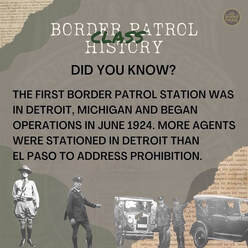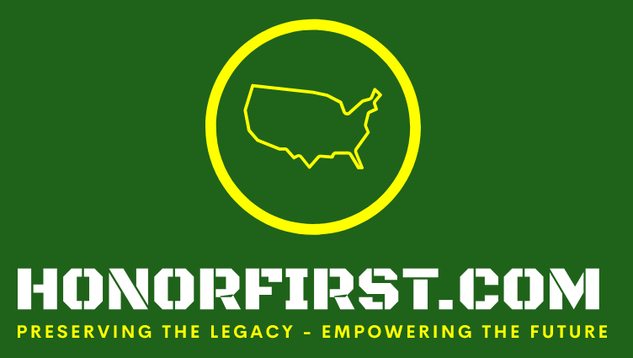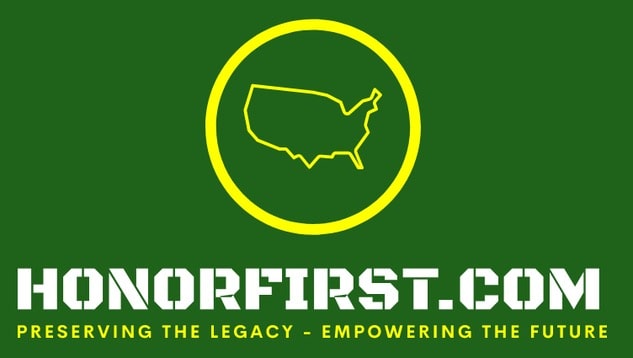October 23 - October 29 Inaccurate history from the USBP's official social media accounts Inaccurate history from the USBP's official social media accounts Good morning! Welcome to another This Week in USBP History! Before I start the intro, let me extent a huge thank you to Joe Banco. He shared over 1,000 Border Patrol photographs with me and gave me permission to post them in the Honor First Photo Galleries. I updated every gallery with his photos. Visit the Honor First Photo Galleries! If you think about it, researching history is very similar to investigating a crime which is to say there is a general understanding of what happened but many of the details are missing. Further, the evidence that is discovered during the investigation may reshape and sometimes entirely change the initial perspectives. Folklore and inaccurate history are created when the gaps of the unknown are filled with inaccurate and/or untrue narratives that are presented as fact. All of us know that it is human nature to fill the unknown with what make sense in the absence of information. That is usually done without any bad intent or malice. Examples of Border Patrol folklore and inaccurate history include:
In the past decade, much of the Patrol's historic gaps have been filled with quality research at the National Archives and by using other reputable sources. Even then, some gaps exist and logical inferences must be made. When I use an inference as I write about history you'll see me use the phrases, "indications are" or "it is believed". Joe Banco will be even more direct when he fills in the gaps as when he wrote (emphasis added):
Joe and I allow the evidence found in the old documents to drive the narratives we write, even when the folklore and/or inaccurate history may be more appealing. We always let truth to trump appeal. When we fill in the gaps, we do it based on our opinions which are anchored in significant research and study. Joe and I know, more than most, the challenge and difficulty of correcting folklore and inaccurate history. I have been met with anger for spouting what some considered to be Border Patrol blasphemy and threatened with Border Patrol hell. Some folks couldn't believe that Jeff Milton was neither in the Patrol nor a Patrol Inspector. Other folks were severely offended when I put El Paso's Where the Legend Began phrase in a correct historical context (see the HonorFirst History Page). Joe and I do not put forth such effort for monetary gain. Joe is not showered with riches due to book sales (which you absolutely should purchase), and HonorFirst.com is not monetized. Joe and I enjoy the discovery and the sharing of the knowledge that we acquired about an organization of which we care deeply. However, a single post to Facebook, Instagram and Twitter from an official social media account can destroy hundreds of hours of careful and tedious research. Such posts perpetuate folklore and inaccurate history, concealing the research that has proven that much of the Patrol's history may not be as spectacular or sensational as originally thought, but is undoubtedly far richer and interesting. And more importantly, such perpetuation damages organizational pride. Last week, the photo to the right was launched from several of the Patrol's official social media accounts, perpetuating folklore and inaccurate history. Directly addressing the post's claims:
Those responsible for managing the Patrol's social media must show better diligence when presenting the Patrol's history. One post can derail hours of careful research and damage organizational pride. Thank you for letting me vent! Perhaps a more influential reader or two might be able to remind HQ that the national and sector Strategic Communications shops most be more careful with their Throwback Thursday history posts. I would be happy to vet their historic posts before publication, just as I imagine Joe would too. Today's update begins with at 1928 shooting where two Patrol Inspectors and two Mounted Customs Inspectors faced down alcohol smugglers in El Paso, Texas. We have a 1936 letter from a uniform vender requesting clarification on the color of the leather (there were two colors in use at the time). And we have several updates thanks to Joe Banco's books. There are no know Newton-Azrak Award action anniversaries this week. Therefore, I will highlight the actions of Supervisory Immigration Officer James F. Murphy who received the Newton-Azrak Award in 1988. I have conducted numerous searches and cannot find any additional information on his action. If you have any information about it, please send it my way so I can update the site. We also remember five of the Patrol's fallen on the anniversaries of their deaths. Enjoy the blog and have a great week! Cliff PS -
Esprit de Corps The workplace climate resulting from a combination of organizational pride and employee morale.
Esprit de corps is reinforced through the shared goals, mission and values of the organization and its employees. The definition turns Esprit de Corps into a simple formula and defines parts that comprise organizational pride and employee morale. Esprit de Corps = Organizational Pride + Employee Morale Esprit de Corps is the key to a healthy organization and engaged employees. Honor First is foundational to the Border Patrol's organizational pride and integral to its Esprit de Corps. Documents/Events 1928
Newton-Azrak Award Action Anniversaries Follow this link to see examples of USBP employees Upholding Honor First.
1988 James F. Murphy Supervisory Immigration Officer Glynco, Georgia Supervisory Immigration Officer James F. Murphy was recognized for stopping the assault of a female colleague by a man with a knife in Kingston, Jamaica, in August 1987. USBP Fallen As of May 16, 2022, the U.S. Border Patrol has suffered 152* fallen. Titles:
The facts regarding each officer are presented without major editing of the "language of the day" found in the reports detailing the circumstances of each event. This is done to provide the reader an association with historical timeframes. Employees who died in the line of duty due to being exposed to deadly illnesses will not have the cause of death listed. *With the exception of two of the fallen immediately below, all names are listed (or in the process of being included) on the official Honor Roll of U.S. Border Patrol Fallen and inscribed on the National Law Enforcement Officers Memorial. The U.S. Border Patrol should fix these discrepancies. HonorFirst.com honors both of the fallen.
1925
Ross A. Gardner Date of Birth: July 9, 1900 Entered on Duty: January 2, 1925 Title: Patrol Inspector End of Watch: October 28, 1925 Details: On October 27, 1925, Patrol Inspector Ross A. Gardner was returning from his official station, San Diego, California, to Elsinore, California, where he was temporarily assigned. He was operating a government-owned motorcycle that he had taken to San Diego to be repaired. At Sedoc, California, about three miles east of Elsinore, Inspector Gardner ran into the rear of an automobile that was stalled on the roadway. The stalled vehicle had no lights at the time and, reportedly, headlights on a truck heading in the opposite direction hampered the officer's vision. Patrol Inspector Gardner sustained a fractured skull, fracture of the pelvis, and internal injuries. He was conveyed to Elsinore by a passing motorist but was later transferred to the Naval Hospital in San Diego, California. Death occurred at 4:20 a.m. on October 28, 1925. Gravesite 1968 Ralph L. Anderson Date of Birth: February 16, 1923 Entered on Duty: May 1, 1950 Title: Patrol Inspector End of Watch: October 25, 1968 Details: On October 25, 1968, Patrol Inspector Ralph L. Anderson was assigned to the 8:00 a.m. to 4:00 p.m. shift on the international boundary near San Ysidro, California. He was working alone, checking the drag trails for signs of illegal crossings. Shortly after 4:00 p.m., Patrol Inspector Charles Thompson found Patrol Inspector Anderson in a Service-owned vehicle in a remote area near the Mexican border east of the San Ysidro Port of Entry. There was a bullet wound in Inspector Anderson's right temple and a 218 “Bee” Savage bolt-action rifle inside the vehicle, with the muzzle pointing upward and leaning toward the decedent. Investigation conducted by the FBI revealed that the rifle was carried loosely inside the vehicle with the muzzle upward. A mark on a gearshift lever knob indicated that the trigger of the weapon had fallen against the knob. The impact discharged the rifle, and the projectile struck Inspector Anderson in the right temporal region. There was no indication of any other person or persons having been in the area. San Diego County Deputy Coroner Murphy concluded the mode of death to be accidental. Gravesite 1998 Walter S. Panchison Date of Birth: January 15, 1945 Entered on Duty: March 6, 1978 Title: Airplane Pilot End of Watch: October 23, 1998 Details: On Friday October 23, 1998, at 2:00 p.m., Agent Scott Panchison was flying a U.S. Border Patrol plane in response to motion sensors tripped along the United States - Canadian Border near Lynden, Washington. Agent Panchison was working with other agents in the area and was heading back to Bellingham International Airport when his plane crashed into rugged terrain in the Smith Peak area just north of Mount Baker Highway on the west side of Sumas Mountain. Agent Panchison lost his life in the crash. Agent Panchison was born in Pottsville, Pennsylvania, but grew up in Salt Lake City, Utah. He earned a bachelor’s degree from the University of Utah and a master’s degree from Pepperdine University. After graduation, Agent Panchison joined the U.S. Marine Corps, where he spent ten years flying F4 Phantoms, including flights from aircraft carriers in the Vietnam War. He left the Corps to join the U.S. Border Patrol, where he proudly served for 21 years. At the time of his death, he was stationed at the Blaine Sector. He was a graduate of the 119th session of the U.S. Border Patrol Academy in Glynco, Georgia. Gravesite 2002 Catherine M. Hill Date of Birth: March 19, 1965 Entered on Duty: November 1, 1999 Title: Senior Patrol Agent End of Watch: October 25, 2002 Details: Senior Patrol Agent Catherine M. Hill, 37, was performing patrol duties in the Tijuana River Valley (Smuggler’s Canyon area) early in the morning on Friday, October 25, 2002, when her vehicle rolled down the edge of a 40-foot cliff. She died at the scene. Agent Hill was a graduate of the 419th session of the U.S. Border Patrol Academy and was assigned to the Imperial Beach Station at the time of her death. Known for her outgoing and community-oriented personality, she was an advisor for Border Patrol Explorer post #1924 and a member of the San Diego Sector’s Peer Support Team. Gravesite 2021 Rafael G. Sanchez Entered on Duty: September 16, 2002 Title: Supervisory Border Patrol Agent End of Watch: October 24, 2021 Details: Agent Sanchez entered on duty on September 16, 2002, as part of the 527th Session of the Border Patrol Academy. At the time of his passing, he was assigned to the Hebbronville Station, Laredo Sector, Texas. The circumstances of his passing were reviewed by an executive panel and the CBP Commissioner who determined that this death occurred in the line of duty. He is survived by his wife Anabel; children: Arielle, Maritza, and Rafael; and mother: Corina; sister Nora; and grandchildren: Joshua, Jordyn, and Gianna. Cremated
Comments
|
Clifford GillBlog author, retired U.S. Border Patrol Assistant Chief and, current U.S. Border Patrol employee advocate. Ray HarrisSite founder and owner, former Supervisory Border Patrol Agent and retired Immigration Special Agent. Joseph BancoU.S. Border Patrol historian and retired Deputy Chief Patrol Agent. Archives
July 2024
I prefer that you leave comments. However, if you wish to contact me, please do so by emailing [email protected].
|
- Home
-
For USBP Applicants
-
USBP Pages and Links
- Firearms Qualification Course
- Military Time Buy Back
- Station MWRs
- Transitioning Out of the USBP
- Fast & Furious
- U.S. Border Patrol Fallen >
- Honor First and Esprit de Corps
- USBP Photo Galleries
- U.S. Border Patrol History >
- U.S. Border Patrol Honorary Awards
- Upholding Honor First >
- U.S. Border Patrol Authorized Devices
- Border Patrol Stories
- What's Important Now - Academy Podcast
- Badges
- Veterans
- Tips for the Media
- Links
- Acronyms
- Border Patrol Locations
- Sector/Station FaceBook Pages
- Ten Codes
- Online Forums
- Search
- Home
-
For USBP Applicants
-
USBP Pages and Links
- Firearms Qualification Course
- Military Time Buy Back
- Station MWRs
- Transitioning Out of the USBP
- Fast & Furious
- U.S. Border Patrol Fallen >
- Honor First and Esprit de Corps
- USBP Photo Galleries
- U.S. Border Patrol History >
- U.S. Border Patrol Honorary Awards
- Upholding Honor First >
- U.S. Border Patrol Authorized Devices
- Border Patrol Stories
- What's Important Now - Academy Podcast
- Badges
- Veterans
- Tips for the Media
- Links
- Acronyms
- Border Patrol Locations
- Sector/Station FaceBook Pages
- Ten Codes
- Online Forums
- Search


 RSS Feed
RSS Feed
